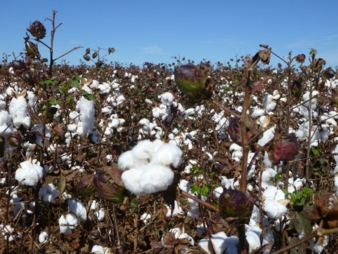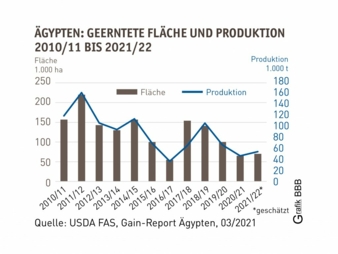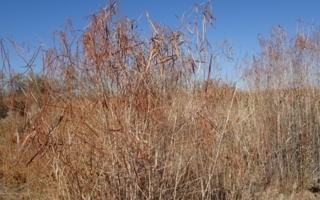12/05/2021 – Losses from 2020/21 season made up — auf Deutsch lesen
Egypt: Increasing cotton production 2021/22
Post attributes the increase to higher area harvested and containment of the white fly infestation that caused losses in 2020/21.
Post estimates production of 2021/22 at 54,000 tonnes compared to 47,000 tonnes in 2020/21. Post attributes the increase to higher area harvested and containment of the white fly infestation that caused losses in 2020/21. Cotton yields declined in 2020/21 due to low quality seeds and losses from whitefly infestation.
Progress 2018/19 to 2020/21 season
In season 2018/19, improved cottonseed varieties pushed yields upward while, during the same period, area harvested increased to 141,000 ha. In 2018/2019, production increased to 106,000 tonnes, an increase of 63 percent over the 65,000 tonnes produced in 2017/18 and 190 percent above 2016/17 production.
The increase reflected farmers’ reaction to the high government announced indicative price, which came at a time of greater restrictions on rice cultivation, further pushing farmers toward expanding cotton acreage. As a result, supply outstripped demand, forcing prices downward. As a result of the low prices, farmers and industry decreased production in the following season 2019/20 to raise cotton prices and to preserve the industry’s reputation as a supplier of high-quality cotton. However, prices remained low.
In 2020/21, yields are returning to normal with an official USDA estimate of 720 kilogram per hectare. The whitefly control program paid off successfully and the losses encountered with last year’s production were contained.
Lower cotton consumption due to the renovation program
Post forecasts 2021/22 consumption to decrease by 16,000 tonnes to 120,000 tonnes, a drop of 13 percent over last year. Post attributes the decrease in local consumption to the decline in demand from public spinners due to the renovation program the Egyptian government recently initiated. While the public spinners are being renovated, they are not operating at full capacity.
There are media reports that Egypt plans to set up the world’s largest spinning and weaving factory in Mahalla al-Kubra, at a cost of about EGP 900 million (57 million dollar). The factory is scheduled to be completed by the end of 2021, after the coronavirus pandemic delayed construction. It marks a major step towards further developing the Egyptian textile industry by investing more than EGP 21 billion (1.3 billion dollar) over two years.
Source: USDA/FAS, Gain Report, 03/2021
Bremer Cotton Exchange – Bremen Cotton Report, issue No. 17/18 2021





